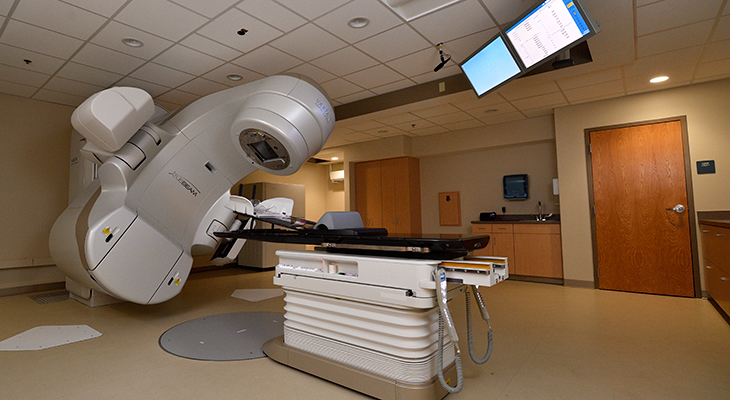New developments allow brain tumor specialists to pinpoint cancer cells with extreme accuracy.

Gamma Knife, CyberKnife, and TrueBeam may sounds like superheroes, but they are actually tools for treating brain tumors. These three machines are used for stereotactic radiosurgery (SRS), a non-surgical treatment option that uses high doses of precisely focused radiation beams to destroy cancer cells.
What is Stereotactic Radiosurgery (SRS)?
Older versions of radiation therapy cast a wide net of radiation around the tumor, which damages the surrounding healthy tissue. These treatments can last over a period of weeks. But new developments in SRS allow practitioners to pinpoint cancer cells with extreme accuracy and can address tumors in less than a week in some cases, compared to the sometimes weeks-long traditional radiation therapy.
Benefits of TrueBeam SRS
- Non-invasive procedures mean no need for anesthesia and lower risks than traditional surgery. Gamma Knife requires an invasive headframe screwed temporarily to the patient’s skull.
- Minimal recovery time means you can get back to your normal activities almost immediately.
- Patients have none of the usual pain and discomfort associated with a typical invasive surgical procedure.
SRS at Norton Healthcare
The TrueBeam platform is an innovation on the much older Gamma Knife and CyberKnife platforms. “The advantages of the TrueBeam platform include no invasive head frame like the Gamma Knife, improved tumor localization and increased particle energy compared to both GammaKnife and CyberKnife. For the patient, that means treatment times which are up to 80% faster than either older technology,” said Aaron C. Spalding, MD, PhD, radiation oncologist who serves as the Executive Medical Director for Norton Cancer Institute. He added, “We made sure that the technology available for our patients was the most advanced today. That is our commitment to our region for beyond state of the art care.”
SRS procedures on the brain involve a team of professionals from many areas, including oncologists (cancer doctors), radiation specialists, neurologists (brain doctors) and patient navigators. “The TrueBeam has allowed our advanced team of specialists to push the envelope for faster, safer care,” David A. Sun, M.D., Ph.D., neurosurgeon and executive medical director of Norton Neurosciences Institute.
Comparison of Gamma Knife®, TrueBeam® and CyberKnife®
All three treat the same cancers but they don’t all treat the same parts of the body. While the Gamma Knife can only treat brain tumors, both the TrueBeam and Cyberknife can treat tumors in the body. However, the up to two-hour treatment time of the Cyberknife means more patient discomfort.
Refer a patient
The Brain Tumor Center is a collaboration of Norton Neuroscience Institute and Norton Cancer Institute and offers same-day appointments for newly diagnosed patients. This multidisciplinary program offers the latest in treatment options like TrueBeam.
TrueBeam and Cyberknife both have robotic surgical systems.
- Comfort can vary among these systems. TrueBeam offers a comfortable couch and no metal head frame to secure the patient’s head. Patients do not need anesthesia. TrueBeam’s onboard scanning systems help the machine correct for any movement as it tracks the tumor cells, even as the patient breathes. CyberKnife offers a similar arrangement, but with treatment times up to two hours due to the low energy photon used. Gamma Knife procedures require sedation and the patient’s head is restrained in a metal frame.
- Treatment times vary slightly between machines. When the Gammaknife was invented in 1967, the patient wore an invasive headframe for hours while treatment took up to an hour. Similarly, the Cyberknife’s development in 2001 meant treatment times over an hour. In part this is due to the lower photon energy of these machines. However, the TrueBeam platform with higher megavoltage photons is able to accurately deliver radiation to targets as small as 0.5mm usually less than 15 minutes.
The TrueBeam platform can effectively simultaneously treat 20 or more brain tumors quickly. The result for the patient is of their brain tumors while sparing memory and speech centers, preserving quality of life.
Trust the experts
By choosing the TrueBeam platform, Norton Healthcare is able to fully utilize the training and skill of the medical team using the machines. “There are many ways to achieve the results we want,” David A. Sun, M.D., Ph.D., executive medical director of Norton Neurosciences Institute. “We use all the skills and tools at our disposal to offer the highest levels of stereotactic radiosurgery care.”
“We have a team of highly trained experts, and we use the best skills of all of our players,” Dr. Sun said. “And that makes all the difference in the world.”

